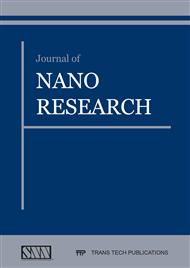[1]
A. Beskok and G. E. Karniadakis. Report: a model for flows in channels, pipes, and ducts at mi- cro and nano scales. Microscale Thermophysical Engineering, 3(1): 43-77, 1999. doi: 10. 1080/108939599199864. URL http: /dx. doi. org/10. 1080/108939599199864.
DOI: 10.1080/108939599199864
Google Scholar
[2]
R. B. Bird, W. E. Steward, and E. N. Lightfoot. Transport phenomena. John Wiley and Sons, New York, (2002).
Google Scholar
[3]
W. Chen, X. JingJuan, C. HongYuan, and X. XingHua. Mass transport in nanofluidic devices. Science China Chemistry, 55(4): 453-468, 2012. ISSN 1869-1870. doi: 10. 1007/s11426-012-4542- 9. URL http: /dx. doi. org/10. 1007/s11426-012-4542-9.
DOI: 10.1007/s11426-012-4542-9
Google Scholar
[4]
N. Dongari, A. Sharma, and F. Durst. Pressure-driven diffusive gas flows in micro-channels: from the knudsen to the continuum regimes. Microfluidics and Nanofluidics, 6: 679-692, (2009).
DOI: 10.1007/s10404-008-0344-y
Google Scholar
[5]
C. Duan, C. Wang, and Q. Xie. Review article: Fabrication of nanofluidic devices. Biomicrofluidics, 7 (2): 026501, 2013. doi: http: /dx. doi. org/10. 1063/1. 4794973. URL http: /scitation. aip. org/content/aip/journal/bmf/7/2/10. 1063/1. 4794973.
DOI: 10.1063/1.4794973
Google Scholar
[6]
M. Fichman and G. Hetsroni. Viscosity and slip velocity in gas flow in microchannels. Physics of fluids, (2005).
DOI: 10.1063/1.2141960
Google Scholar
[7]
W. H. Fissell, A. T. Conlisk, S. Datta, J. M. Magistrelli, J. T. Glass, A. J. Fleischmanand, and S. Roy. High knudsen number fluid flow at near-standard temperature and pressure conditions using precision nanochannels. Microfluidics and Nanofluidics, 10(2): 425-433, 2011. ISSN 1613-4982. doi: 10. 1007/s10404-010-0682-4. URL http: /dx. doi. org/10. 1007/s10404-010-0682-4.
DOI: 10.1007/s10404-010-0682-4
Google Scholar
[8]
A. J. Francis and A. L. Garcia. The direct simulation monte carlo method. Comput. Phys., 11(6): 588-593, January 1997. ISSN 0894-1866. doi: 10. 1063/1. 168619. URL http: /dx. doi. org/10. 1063/1. 168619.
DOI: 10.1063/1.168619
Google Scholar
[9]
S. Gruener and P. Huber. Knudsen Diffusion in Silicon Nanochannels. Physical Review Letters, 100 (6): 064502, February (2008).
DOI: 10.1103/physrevlett.100.064502
Google Scholar
[10]
T. Grzebyk and A. Z. Drzazga. Vacuum micro devices. Bulletin of the Polish academy of science, Technical sciences, 60, (2012).
DOI: 10.2478/v10175-012-0004-y
Google Scholar
[11]
S. Karakitsiou, S. D. Eder, B. Holst, and A. C. Hoffmann. Design, development and testing of appa- ratus to study gas diffusion in nanochannels. TechConnect Briefs 2015, pages 214-217, (2015).
Google Scholar
[12]
S. Karakitsiou, B. Holst, and A. C. Hoffmann. Apparatus for measuring pressure-driven transport through channels at high knudsen numbers. Review of Scientific Instruments, 87(12): 125104, 2016. doi: 10. 1063/1. 4963695. URL http: /dx. doi. org/10. 1063/1. 4963695.
DOI: 10.1063/1.4963695
Google Scholar
[13]
M. Knudsen. Die gesetze der molekularst"omung und der inneren reibungsstr"omung der gase dur r"ohen. Annalen der Physik, 333: 75-130, (1909).
DOI: 10.1002/andp.19093330106
Google Scholar
[14]
S. Li, Z. Xu, M . Aaron, D. J Burns, G. Fuand, M. Dirckx, V. Shilpiekandula, X. Chen, N. C. Nayak, E. W Eehern, S. Y. Yoon, Z. P. Fang, K. Y. Toumi, D. Hardt, S. B Tor, C. YYue, and J. H. Chun. Review of production of microfluidic devices: material, manufacturing and metrology. Proc. SPIE, 6993: 69930F-69930F-12, 2008. doi: 10. 1117/12. 781942. URL http: /dx. doi. org/10. 1117/12. 781942.
DOI: 10.1117/12.781942
Google Scholar
[15]
A. Munjiza, E. Rougier, and N. W. M. John. Discrete element method for molecular scale visualiza- tion of micro-flows. Journal of Flow Visualization and Image Processing, 14: 17-34, (2007).
DOI: 10.1615/jflowvisimageproc.v14.i1.20
Google Scholar
[16]
P. Norberg, A. Ackelid, I. Lundstr¨ om, and L. G Petersson. On the transient gas flow through catalyti- cally active micromachined channels. Journal of Applied Physics, 81: 2094-2100, (1997).
DOI: 10.1063/1.364261
Google Scholar
[17]
W. G. Pollard and R. D. Present. On gaseous self-diffusion in long capillary tubes. Phys. Rev., 73: 762-774, 1948a.
DOI: 10.1103/physrev.73.762
Google Scholar
[18]
W. G. Pollard and R. D. Present. On gaseous self-diffusion in long capillary tubes. Physical Review, 73: 762-774, 1948b.
DOI: 10.1103/physrev.73.762
Google Scholar
[19]
A. Roth. Vacuum Technology. Elsevier Science B. V, Amsterdam, (1990).
Google Scholar
[20]
S. Roy, R . Raju, H. F. Chuang, B. A. Cruden, and M. Meyyappan. Modeling gas flow through mi- crochannels and nanopores. Journal of Applied Physics, 93(8): 4870-4879, 2003. ISSN 0021- 8979. doi: 10. 1063/1. 1559936.
DOI: 10.1063/1.1559936
Google Scholar
[21]
S. A. Tison. Experimental data and theoretical modeling of gas flows through metal capillary leaks. Vacuum, 44(1112): 1171 - 1175, 1993. ISSN 0042-207X. doi: http: /dx. doi. org/10. 1016/ 0042-207X(93)90342-8. URL http: /www. sciencedirect. com/science/article/pii/0042207X93903428. Special Issue 7th International School on Vacuum, Electron and Ion Technologies.
DOI: 10.1016/0042-207x(93)90342-8
Google Scholar
[22]
T. Veijola. End effects of rare gas flow in short channels and squeezed-film dampers. Technical proceedings of the 2002 international conference on modeling and simulations of microsystems, 1: 104-107, (2002).
Google Scholar
[23]
A. E. Velasco, S. G. Friedman, M. Pevarnik, Z . S Siwy, and P. Taborek. Pressure-driven flow through a single nanopore. Phys. Rev. E, 86: 025302, Aug 2012. doi: 10. 1103/PhysRevE. 86. 025302. URL http: /link. aps. org/doi/10. 1103/PhysRevE. 86. 025302.
DOI: 10.1103/physreve.86.025302
Google Scholar


